Perform Post-Installation Tasks
If everything has gone as expected, your Mac is now successfully running Catalina. (If things haven’t gone as expected, flip forward to Troubleshoot Upgrade Problems.) But there are still a few tasks left to do before you get to work—or play—with your new operating system. In this chapter I cover some important initial setup and configuration activities you should get out of the way right now.
Respond to Immediate Questions
Depending on your starting point, configuration, and upgrade path, you may see a normal desktop and nothing more after installing. In other situations—especially when you upgrade older versions of macOS or have a lot of third-party software—you may be immediately confronted with a large stack of overlapping dialogs and notifications.
Among the most common questions are requests for your user account password or Apple ID password. For example, certain apps may once again need an administrator’s authorization to make changes to your data, and various apps that use your Apple ID (including FaceTime and Messages) may need you to sign in again.
Work your way through any such dialogs you see, even if they seem redundant. After that one-time process, most of them will not reappear.
Because of Catalina’s added security features, you’ll likely see a number of additional dialogs, including some you never saw in earlier versions of macOS. I discuss these next.
Annoying New Alerts in Catalina
Earlier, in Endless Security Alerts, I complained about the fact that Catalina has an even larger number of seemingly pointless alerts, asking you to grant permission for still more harmless, day-to-day activities. Here are some examples:
Files and folders: In Mojave, apps had to ask permission the first time they tried to access files in certain locations—see Full Disk Access, ahead. That’s still true, but now there are even more situations in which apps have to ask permission to access files. Basically, if an app wants to access a file it didn’t create—without any manual action on your part such as double-clicking or navigating in an Open or Save dialog—it’s going to throw up a dialog, no matter where the file is (even if it’s in the Trash). You can manage apps to which you’ve granted file access permission in System Preferences > Security & Privacy > Privacy > Files and Folders.
Screen capture: You can still take screenshots and video of what’s on your display, without any extra steps—as long as you initiate it manually (for example, by pressing ⌘-Shift-5). But the first time an app tries to record what’s on your screen—and this includes built-in Apple apps, such as Terminal—you’ll get an alert (Figure 13).
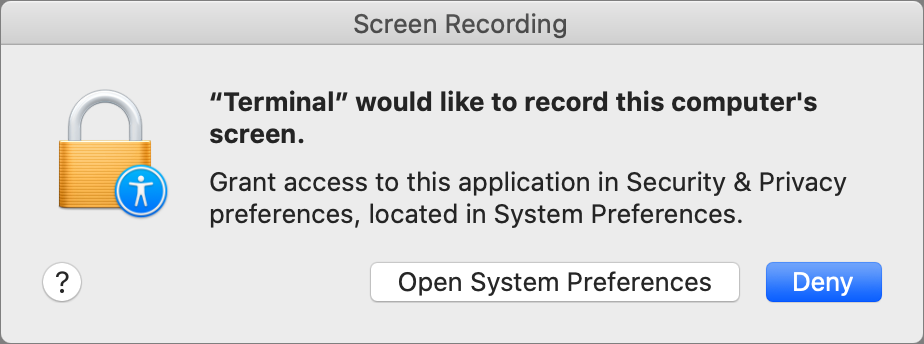
Figure 13: The first time any given app tries to record what’s on your screen, you’ll see an alert like this. To deal with this, click Open System Preferences. Then click the lock
 icon and enter your password. Select the checkbox next to the app in question. If the app is still running, you’ll see a prompt to quit it; you must do so and reopen it to apply the permission you gave to record your screen.
icon and enter your password. Select the checkbox next to the app in question. If the app is still running, you’ll see a prompt to quit it; you must do so and reopen it to apply the permission you gave to record your screen.Non-notarized apps: Notarization is a process by which Apple specially marks an app to show that they have scanned it for malware. (That’s an oversimplification, but it’s close enough for our purposes.) You can’t tell just by looking whether an app has been notarized, but starting in Catalina, if you download a new app that hasn’t been notarized, an alert will pop up saying you can’t run it.
There are a bunch of exceptions and qualifications to this new rule. You’ll still be able to run non-notarized apps that you previously ran under an earlier version of macOS, at least if you do an in-place upgrade. And the notarization requirement applies only to apps you download from somewhere other than the Mac App Store, and even then, apparently only to apps that have been signed with a developer ID. And, although I haven’t been able to test this yet, I believe it’s still the case that if you encounter such an alert, you can right-click (or Control-click) the app, choose Open from the contextual menu, and then click Open in the resulting dialog to open it.
Safari download alerts: The first time you download something from any site using Safari 13, even if you manually initiated the download, Safari prompts you (Figure 14) to ask whether you really want to let it download from that domain.

Notification Requests
You may see one or more alerts like the one in Figure 15 saying that an app wants permission to display notifications. I’ve seen as many as a dozen of these after upgrading to Catalina—including for apps to which I’d previously granted permission. So I’m unsure why they’re reappearing, but in any case, you can handle these however you like.

Accessibility Access
Apps that manipulate the user interface in one way or another to provide system enhancements and extra features may need to use Apple’s accessibility features. Examples include launchers, macro utilities, text-expansion utilities, scripting tools, and window management tools—among many others. The need to get user approval for these tools isn’t new in Catalina, but you may see more alerts like the one in Figure 16, including alerts for apps you previously granted accessibility access in an earlier version of macOS.
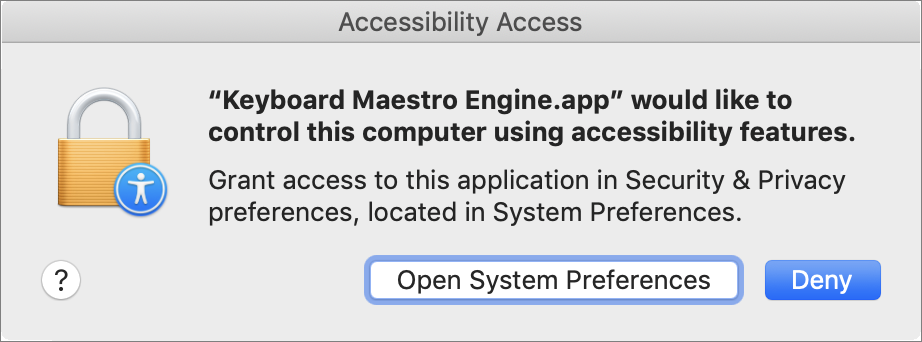
You can’t grant this type of access right in the alert dialog. Instead, you must open System Preferences (manually or by clicking the Open System Preferences button), go to Security & Privacy > Privacy, and select Accessibility in the list on the left (Figure 17). Click the lock ![]() icon at the bottom, enter your password, and click Unlock. Then select the checkbox(es) for the apps to which you want to grant access.
icon at the bottom, enter your password, and click Unlock. Then select the checkbox(es) for the apps to which you want to grant access.

Automation Access
A category introduced in Mojave is automation access. To ask your permission, an app displays a dialog like the one in Figure 18.
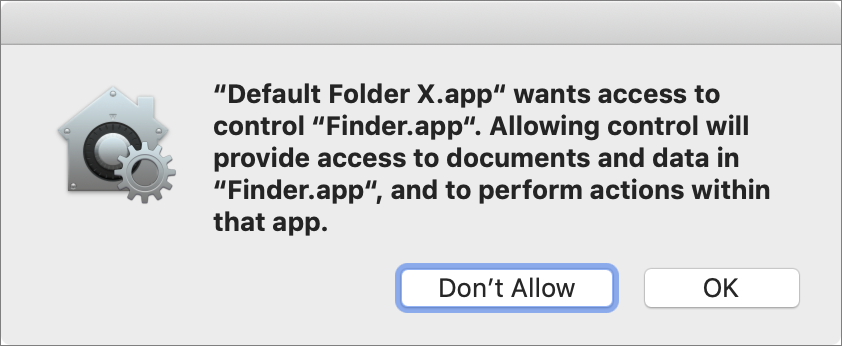
You may notice that this dialog specifies the name of an app (in this case, Finder). Any app or utility that requests automation access must do so individually for each app it wants to control. So you may see this alert multiple times per app. To grant automation access immediately, just click OK in the alert. Alternatively—or if you change your mind about an app later—go to System Preferences > Security & Privacy > Privacy > Automation (Figure 19) and check or uncheck the app(s) you permit the listed utilities to control.

Full Disk Access
Another newer privacy category (introduced in Mojave) is Full Disk Access (formerly called Application Data). This isn’t merely about manipulating the user interface or automating actions within an app; this type of access gives the requesting app permission to read and modify files of a potentially sensitive nature (such as your email and messages). That may sound scary, but all it does is place an extra barrier between the bad guys (especially malware) and your important data. It’s entirely appropriate—indeed, necessary—for you to grant certain types of software access to this data. One example is a Mail plugin, such as SpamSieve, which needs access to your email in order to do its job.
If an app or utility needs access to your files, it will generally notify you in some way. There’s no single system-wide alert for this purpose, but an app may display a dialog such as the one in Figure 20.

Like Accessibility Access, Full Disk Access requires you to manually pop into System Preferences. So, if an app needs this control, go to System Preferences > Security & Privacy > Privacy > Full Disk Access (Figure 21). If the app already appears in the list on the right, check the box next to it. If not, click the plus ![]() button, navigate to the app, select it, and click Open.
button, navigate to the app, select it, and click Open.

Some apps that need Full Disk Access do not notify you. Because of this, they can be completely nonfunctional until you figure out that you need to follow the above steps—and, more confusingly, figure out where to find the actual app file you need to specify.
One such app is Terminal. Although Terminal itself, and most command-line operations, work in Catalina more or less as they always have, some operations that use the sudo command (such as changing file ownership with chmod) work only if you’ve added Terminal to the list of apps in Full Disk Access. (See this discussion for more details.) Oh, and if you’re using Terminal to change ownership on a remote Catalina Mac via SSH, you’ll need to choose Go > Go to Folder in the Finder, enter /usr/sbin, and then drag the SSH daemon (/usr/sbin/sshd) to the Full Disk Access list too.
New Accounts Added
You may see a notification like the one in Figure 22. This means that, in the process of syncing your accounts via iCloud with your other Macs, Catalina found one or more email accounts that were either missing from this Mac or had different settings—and they’ve been added, but not enabled. To enable the accounts, click Continue; Catalina then opens System Preferences > Internet Accounts, where you can verify all the settings. Or, click Later to leave the newly added accounts disabled for the time being.

Handle Software Updates
The next thing you should do is to update macOS itself (and any other crucial Apple software) to the latest version. Sometimes Apple releases bug fixes and security updates almost immediately after a major upgrade, and if any such urgent updates are available, it’s in your best interest to install them right away.
In Catalina, as in Mojave, updates to macOS itself are found in System Preferences > Software Update, while updates to other Apple software—including built-in apps such as Safari, and optional purchases such as Final Cut Pro and Pages—are delivered through the App Store app. And, of course, you can update all the third-party apps you’ve purchased from the App Store at the same time.
In some cases, Software Update and the App Store notify you automatically of updates, but I recommend checking manually, shortly after your Mac starts up under Catalina for the first time. Start with System Preferences > Software Update for updates to Catalina itself. You can open the App Store by clicking its Dock icon, double-clicking its icon in /Applications or clicking it in Launchpad, or choosing Apple > App Store. Then click Updates in the sidebar.
To update a single application, click the Update button next to it. (Apple may group multiple software updates together; if so, click the More link to see details on each one.) Or, to update all the listed apps at once, click Update All in the upper-right corner. The App Store downloads and installs the updates automatically.
In addition to installing any updates, decide how you want Software Update to handle future updates. Your Mac can check for, download, and even install updates in the background. Some people turn off all aspects of automatic updates—perhaps because they never want to be interrupted with alerts about new software, dislike the idea of anything downloading behind their backs, or need to keep an eye on a bandwidth cap. Others want all the new things right away without manual intervention and…ahem…have sufficiently robust backups that they can recover from any problems that may arise due to a buggy update.
Follow these steps to configure software updates:
Go to System Preferences > Software Update (Figure 23). macOS checks for updates, and any available updates appear at the top of the pane. To apply them, click Update Now.

Figure 23: Configure automatic updates in the Software Update pane. To turn on all automatic updates (not the best idea, in my opinion), check “Automatically keep my Mac up to date.” Or, to specify exactly which updates you want macOS to install automatically (a much better idea), click Advanced. A dialog (Figure 24) appears.
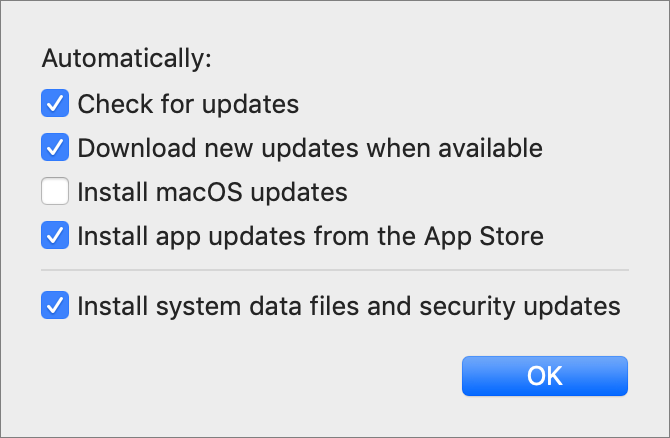
Figure 24: Select which types of automatic updates you want in this dialog. Click the “Check for updates” checkbox (it’s checked by default) to enable or disable automatic checking. (In some situations, you must enter your password after changing this checkbox.) If it’s selected, you can also select any or all of:
Download new updates when available, which not only notifies you of updates but also downloads them for you so you can install them as soon as you’re ready (in the notification, click Install to install immediately; click Later and choose Try in an Hour, Try Tonight, or Remind Me Tomorrow from the pop-up menu to “snooze” the reminder; or click the notification itself to open the App Store and see which updates are available)
Install macOS updates, which downloads and installs updates to macOS itself—that is, macOS 10.15.x—and asks you to restart your Mac (you may be prompted for your password if you change this checkbox)
Install app updates from the App Store, which silently updates installed apps from the App Store (except those requiring a restart or other interaction)
- Install system data files and security updates, which automatically (without prompting you) installs these essential updates—but only after they’ve been available in the App Store for 3 days
Although you’re welcome to check whichever of these boxes you like, my personal preference (and recommendation) is to check all of them except “Install macOS updates” (as shown in Figure 24, above). I like having most of my software updated automatically, but for system updates, I prefer to wait until I’ve confirmed that other users aren’t experiencing any major problems with them, and then apply them when I’m ready.
Review the Relocated Items Folder
During some of my test installations, the Catalina installer placed an alias named Relocated Items on my desktop; it pointed to a folder located in /Users/Shared, which in my case mostly contained other empty folders, and for some reason a virtual memory swapfile. As of publication time, Apple has not publicized an official description of what this folder is for or why it’s there, but from reading about other people’s experiences, it appears to contain items that the Catalina installer didn’t know what to do with. This might be a beta version quirk that disappears in the final release. In any case, if you see such a folder, it’s a good idea to look through it just to see if there’s anything of interest—for example, command-line software you need to reinstall. Until we have more official guidance, I recommend against simply deleting the original folder, though it’s fine to delete the alias on your desktop.
Review the Incompatible Software Folder
If the Catalina installer encounters any known incompatibilities, it moves the problematic software to an Incompatible Software folder and explains what it moved on one of the final screens of Setup Assistant. (After Setup Assistant quits, you can find the Incompatible Software folder at the top level of your startup volume, at the top level of your home folder, or even in both places, depending on the location of the software that was disabled.)
This notice appears only for extensions and other low-level background software that would otherwise run automatically when you start up your Mac. As it says, the items in question are moved aside but not deleted. Whatever you do, don’t try to re-enable this software manually! Instead, contact the developer and get a version that’s compatible with Catalina, and then reinstall it.
Deal with Other Surprises
You may encounter a few other peculiarities when first using Catalina that cause some initial surprise.
Apple Mail
If you’ve been using Apple Mail through a few macOS upgrades, you may be familiar with extra steps that typically occur at this point. Mojave made even more changes than usual, so if you’re upgrading from a version of macOS older than Mojave, the new behavior may be surprising; read on for the full story. If you were already using Mojave, pretty much the only thing you should need to know is that all your Mail plugins will need upgrades—yet again—for Catalina compatibility.
Importing Mail Messages
In some cases (more likely when using Plan B than Plan A—and even then, only when you’re upgrading from a pre–Mojave system), the first time you launch Mail, a window informs you that it’s “upgrading” your mail database. This step should take no more than a few minutes, and is necessary because the Catalina version of Mail has updated the database format it uses to store information about your messages.
Mail Plugins
For many years, new versions of macOS have disabled Mail plugins, requiring users to install updated versions for compatibility. That’s still true, but more so: starting in Mojave, Apple changed both the mechanism for enabling or disabling Mail plugins and added confusing hoops the developer (and you) must jump through to make them work. (These steps will be new for you if you weren’t already running Mojave, but even if you were, you’ll almost certainly have to download and install new, Mojave-compatible versions of all your Mail plugins.)
First of all, most Mail plugins now require an external helper app (typically, one that runs in the background—either all the time, or just when Mail is open) to do the heavy lifting. That app requires access to all your Mail files (which, of course, may contain sensitive information), and although the app can display an alert informing you of this fact, you’ll have to grant this permission manually. For an example, and instructions on what to do, flip back to Full Disk Access.
But that is not all, oh no, that is not all!
Even if you’ve given a plugin (or, more specifically, its external app) permission to access your files, you must now also enable that plugin within Mail. To do so, open Mail, go to Mail > Preferences > General, and click the Manage Plug-ins button at the bottom (Figure 25), which appears only when you have at least one plugin installed.

When you do so, Mail opens a dialog that lists all installed plugins (Figure 26). Here, select the checkbox next to any plugin you want to enable. Then click Apply and Restart Mail—which, as the name suggests, quits and restarts Mail, this time with your plugin(s) enabled.
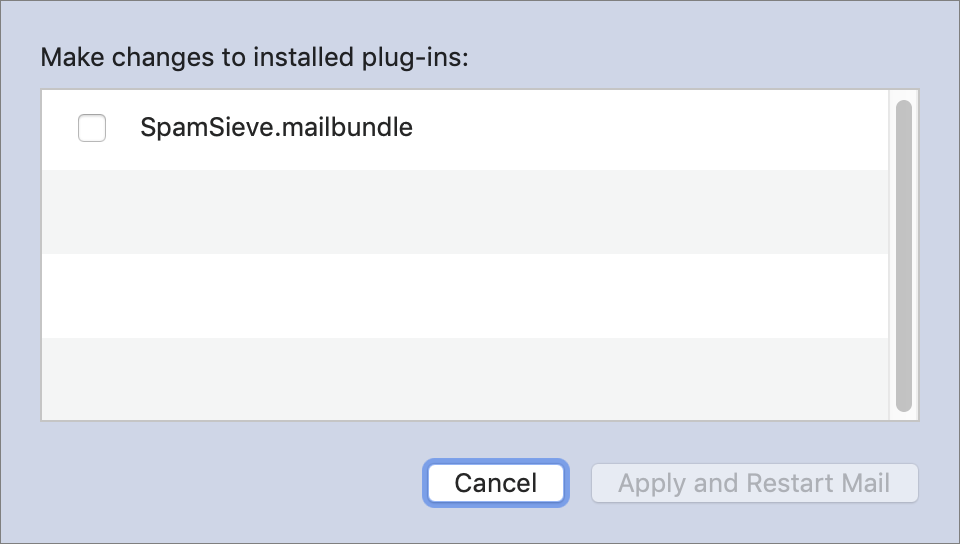
Now then…there’s yet another gotcha. Nothing prevents you from checking the box to enable an old (pre-Mojave) Mail plugin that hasn’t been updated for Catalina compatibility. If you do that, Mail may hang on launch, and now you can’t go back to that dialog to disable the plugin that’s causing problems! If this happens to you, force-quit Mail (press Option, click and hold Mail’s Dock icon, and choose Force Quit from the popover). Then go to ~/Library/Mail/Bundles and locate the offending plugin(s). Move them out of that folder (for example, into ~/Library/Mail/Bundles (Disabled) if it’s present, or onto your desktop). Then reopen Mail—and check with the plugin’s developer to see if a Catalina-compatible version is available.
Books
If you are upgrading to Catalina from a pre-Mojave system, you should know that the app formerly known as iBooks was renamed to Books in Mojave, thus joining apps like Calendar, Contacts, Mail, Messages, Notes, Numbers, Pages, Photos, and Reminders, all of which have names that are boringly descriptive and impossible to find in a web search because they’re just generic nouns. Bah.
Music, Podcasts, and TV
These three apps replace most of the features formerly found in iTunes. And, of course, like Books, they have ridiculously boring names. I have nothing to say about these apps here except that they exist. Scholle McFarland provides basic coverage in Take Control of Catalina, and other books (yet to be updated) will go into more detail.
First-Run Alerts
After upgrading to Catalina, you may see an alert (Figure 27) the first time you open a previously installed third-party app that wasn’t downloaded from the App Store.
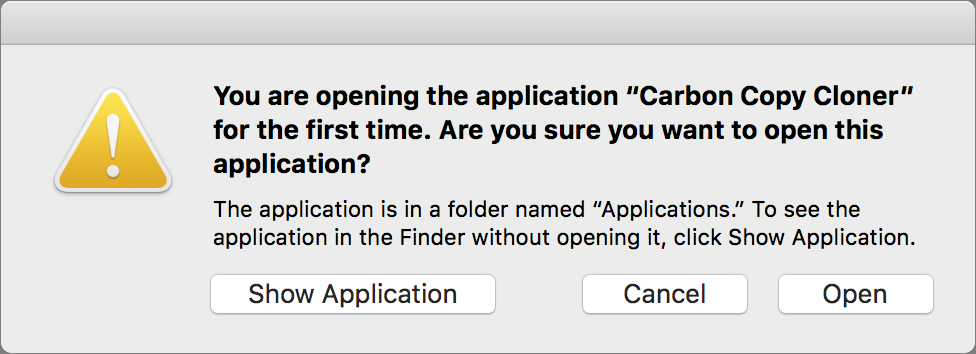
This alert doesn’t appear if you double-click the app icon, but it does if you open the app indirectly, such as by double-clicking one of its files. To confirm that you did intend to launch that app, click Open.
Safari Extensions
Catalina includes Safari 13, which has some significant changes (and was available even before Catalina shipped). In particular, if you use any Safari extensions, you may notice a confusing and off-putting dialog when Safari 13 first opens, telling you that your old extensions no longer work. The good news is that Safari has made browsing safer and more private, and reduced the opportunities for malware to affect your browsing. The bad news is that this may require effort on your part (finding new versions of, or alternatives to, certain extensions, for example) and, in some cases, abandoning extensions that you previously relied on.
To make a long story short, you’ll now have to obtain all your Safari extensions from either Apple’s Safari Extensions Gallery or the App Store (which now has a special category for Safari Extensions); Apple is pushing developers to the App Store, which will soon be the only place to get Safari extensions, since submissions to the Safari Extensions Gallery are no longer being accepted.
Kernel Extension Blocking
In Mojave, Apple displayed an alert whenever you tried to install a new third-party kernel extension (or KEXT). In Catalina, you can’t use them at all (refer back to App Incompatibility). Unfortunately, there’s not much I can say about this except the obvious: if third-party hardware or software no longer works, it could be that it relied on a KEXT that doesn’t run under Catalina. Check the developer’s website for updates.
System Preferences Changes
Catalina completely rearranges the icons in System Preferences, so it may require a little extra searching to find the pane you’re looking for. There’s also the usual assortment of small cosmetic changes in System Preferences, along with some more significant ones:
Accessibility: The Accessibility pane is significantly rearranged, and also has some new features. A new Overview category does nothing but tell you about the pane; the options formerly in the General category at the top (checkmarks to make various features appear, or not, in the Accessibility pop-up window) are now in a Shortcut category. In addition:
Display: This category has more options now, so they’re divided among Display, Cursor, and Color Filters tabs.
Keyboard: The Hardware pane of the Keyboard category now has an Enable Typing Feedback checkbox and an accompanying Options dialog that lets you choose any or all of four different categories of keys to receive audio feedback as you press them.
Pointer Control: This new category replaces Mouse & Trackpad. It has a Mouse & Trackpad tab, which now displays controls for double-click speed and spring-loading delay, and an Alternate Control Methods tab, with settings for Mouse Keys and Alternate Pointer Actions.
Speech: A new option in this category is “Speak items under the pointer.”
Switch Control: You can now select Light or Dark appearance on the General tab.
Voice Control: This is a brand-new category, with settings for controlling your Mac (beyond what Siri and Dictation can do) using your voice. For example, you can now choose menu commands, scroll, select text, move the pointer, and much more using your voice.
Zoom: You can now separately zoom each display, and the arrangement of controls is quite a bit different now; for example, what you previously found by clicking Options next to “Zoom style” is now divided between Appearance and Controls tabs when you click the new Advanced button.
Apple ID: The iCloud preference pane is gone. Its functions have been taken over by the new Apple ID pane (Figure 28), which now appears at the very top of System Preferences once you’ve signed in to your iCloud account. (If you haven’t signed in yet, a message at the top invites you to do so by clicking Sign In.)

Figure 28: The new Apple ID pane of System Preferences, with the iCloud category selected on the left. In fact, the Apple ID pane gives you a central location to manage a bunch of things related to your Apple ID, grouped by categories, which appear on the left:
Overview: Sign out of your Apple ID on this device, or get information about Apple’s privacy policies for Apple IDs.
Name, Phone, Email: View and edit various personal details, as well as contact preferences.
Password & Security: Change your password, add trusted phone numbers, get verification codes, and enable two-factor authentication.
Payment & Shipping: View and edit the payment method and shipping address associated with your Apple ID.
iCloud: This category displays most of what was previously in the iCloud pane of System Preferences. It lets you turn iCloud off or on for various apps and features, enable or disable Optimize Mac Storage, and manage iCloud storage for each app.
Media & Purchases: This category lets you manage subscriptions and specify when passwords are required for both the Mac App Store and the Books Store.
Devices: Every device associated with your Apple ID appears at the bottom of the list on the left. You can select a device to see information about it (such as which operating system it’s running and its serial number) and remove it from your account (if you no longer use it).
Desktop & Screen Saver: On the Desktop tab, the pop-up menu command for changing pictures now reads Automatic rather than Dynamic, there’s a new Catalina-themed Dynamic Desktop, and there’s a new category (under Apple) of Legacy Desktops, with a selection of desktop pictures from earlier versions of macOS.
Family Sharing: Family Sharing features were previously handled in the iCloud pane. Now there’s a separate pane to set up and configure the many Family Sharing features—but it appears only if you’ve signed in to your Apple ID account.
General: In addition to selecting Light or Dark appearance, you can now select Auto (to change appearance based on time of day).
iCloud: In case you’re looking for iCloud in this list and not reading linearly, see the “Apple ID” bullet above.
Keyboard: The Dictation tab no longer includes a Use Enhanced Dictation option, as apparently that capability is now built in.
Mission Control: As Dashboard is no longer a feature in Catalina, the Dashboard pop-up menu is now gone.
Notifications: Each app on the Notifications pane now has a prominent on/off switch, to enable or disable notifications for that app without having to check or uncheck each individual setting.
Screen Time: iOS 12 introduced Screen Time, and now it’s available on your Mac, too. This collection of features lets you monitor how much time per day each of your Mac’s users spends in various apps and place limits on app usage and various types of content.
Security & Privacy: The Privacy tab has new categories for Speech Recognition and (as I mentioned in Annoying New Alerts in Catalina) Files and Folders.
Sharing: A new Media Sharing option lets you share your music, movies, and TV shows with other devices on your network. This includes Home Sharing, which was previously built into iTunes.
Sidecar: This new preference pane appears once you’ve connected to an iPad as an external display; it enables you to configure whether or where the iPad displays a sidebar and (if applicable) a Touch Bar, and lets you choose whether to enable a double-tap gesture on an Apple Pencil. (To use an iPad running iPadOS 13 as an external display, choose it from your Mac’s AirPlay
 menu.)
menu.)
Final Software Advice
The best way to confirm that you have all your software installed and configured correctly is to try each application:
Go through your
/Applicationsfolder (including theUtilitiesfolder and anyplace else you’ve stored applications) and launch each app, one at a time. If an app uses plugins that you’re aware of, try to exercise at least one or two of them. When you’ve verified that the app works, quit it and move on to the next. Do the same with each of your third-party preference panes, by accessing them in System Preferences. (You needn’t do this all in one sitting—feel free to spread it out over several days or longer.)Make sure your important data displays correctly in the appropriate places, such as: contacts in Contacts, events in Calendars, stored email in Mail, photos and media in Photos and iTunes, and browser bookmarks in Safari.
Similarly, if you use any third-party cloud storage services (such as Dropbox, OneDrive, or Google Drive), confirm that the relevant apps are running and that your data is in sync.
If you use Unix software (including command-line tools and X11 applications), check to see that it’s still present and functional. In particular, if you manually installed anything in
/bin,/sbin, or/usr(except in/usr/local or/usr/share) in Yosemite or earlier, it will be gone—those are protected directories now, so you’ll have to reinstall those items in another location or restore them to a different directory from your backup.Also, if you use one of the following package managers, you’ll want to update it and all the binaries you’ve installed using it:
Fink: Update to the latest version. Try
fink selfupdatefirst; if that doesn’t work, download a fresh copy.Homebrew: Use
brew updateto update Homebrew itself, and thenbrew upgradeto upgrade all your packages.MacPorts: Follow these migration instructions and install the latest version.
After following these steps and using Catalina for a few days, if you haven’t discovered any missing files or software that doesn’t work, you can conclude that Catalina is working properly, and you can overwrite your just-before-upgrading bootable duplicate with a new version (remember, you turned off duplicates in Turn Off (Yes, Off) Automatic Duplicates?)—and turn automatic duplicates back on.